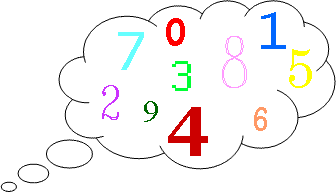Think of two numbers
Think of two whole numbers under 10, and follow the steps. I can work out both your numbers very quickly. How?
Problem
Think of Two Numbers printable worksheet
Here is an alternative and more unusual version of the "Think of a Number" trick which you may have heard of before.

Think of two whole numbers under $10$.
Take one of them and add $1$.
Multiply by $5$.
Add $1$ again.
Double your answer.
Subtract $1$.
Add your second number.
Add $2$.
Double again.
Subtract $8$.
Halve this number and tell me your answer.
From your answer I can work out both your numbers very quickly. How?
Choose some different pairs of numbers and repeat the process.
Can you figure out how the trick works?
Click here for a poster of this problem.
Getting Started
The tens digit tells you one number and the unit digit tells you the other.
Student Solutions
Although we had lots of answers to this problem, very few of you explained your solutions carefully. Alistair from Histon and Impington Infant School sent us this solution:
I started by working out a few answers, and spotted that (if A is the first number and B is the second), A goes up and the number of the answer goes up by 10, and B goes up and the answer goes up by 1. My chart:
| 1 | 2 | 3 | 4 | 5 | |
| 1 | 20 | 30 | 40 | 50 | 60 |
| 2 | 21 | 31 | 41 | 51 | |
| 3 | 22 | 32 | 42 | 52 | |
| 4 | 23 | ||||
| 5 | 24 |
So then I made a new chart, showing what numbers you would get at different steps of the operations:
| A | 1 | 1 | 1 | 2 | 3 | 4 | 2 | |
| B | 1 | 2 | 3 | 1 | 1 | 1 | 2 | |
| A+1 | 2 | 2 | 2 | 3 | 4 | 5 | 3 | A+1 |
| x5 | 10 | 10 | 10 | 15 | 20 | 25 | 15 | 5A+5 |
| +1 | 11 | 11 | 11 | 16 | 21 | 26 | 16 | 5A+6 |
| x2 | 22 | 22 | 22 | 32 | 42 | 52 | 32 | 10A+12 |
| -1 | 21 | 21 | 21 | 31 | 41 | 51 | 31 | 10A+11 |
| +B | 22 | 23 | 24 | 32 | 42 | 52 | 33 | 10A+11+B |
| +2 | 24 | 25 | 26 | 34 | 44 | 54 | 35 | 10A+13+B |
| x2 | 48 | 50 | 52 | 68 | 88 | 108 | 70 | 20A+26+2B |
| -8 | 40 | 42 | 44 | 60 | 80 | 100 | 62 | 20A+18+2B |
| /2 | 20 | 21 | 22 | 30 | 40 | 50 | 31 | 10A+9+B |
So the answer is always 10A + B + 9. If you are told the answer, you must take away nine, then the digits of the answer are the numbers that your friend thought of.
Chris, Isobel, Wui Shen and Alex from Maadi British International School in Cairo noticed something else:
We thought about the problem and worked it out together first. When we had our answer we tried to work out how to get our first numbers.
Wui Shen said we could take 1 away from the tens column and + 1 to the units column.
Isobel said we could + the two numbers and find two numbers that equal the same number.
We then each did our own sum and discovered Wui Shen's worked every time but Isobel's didn't because there was more than one answer to the sum.
Jordan from London explained why Wui Shen's method works:
10A + B + 9 gives the final answer.
If you subtract 9 from this you are left with 10A + B.
A and B are whole numbers less than 10; this means that multiplying A by 10 would give a result with 0 in the units column and A in the tens column.
After that the addition of B to 10A would put B in place of the 0, so A would be the tens digit and B would be the units digit.
When 9 is taken away from a number it is the same as subtracting 10 (the tens column decreases by 1), and then adding 1 (the units column increases by 1).
Therefore decreasing the tens column value by 1 and doing the opposite to the units column value has the same effect as subtracting 9. Both leave you with A and B as the two digits.
This is what Wui Shen found.
Teachers' Resources
Why do this problem?
This problem can be solved by both trial and improvement and by using simple algebra. It is the intriguing kind of "puzzle-game" that can be taken from the maths classroom into the playground! A poster of this problem is available here.
Possible approach
This printable worksheet may be useful: Think of Two Numbers.
You could introduce the problem as it appears on the site as a printed sheet or on a computer. Learners could first work individually to give them 'thinking time', then work in pairs to support each other and to give an opportunity for mathematical talk, and finally there could be a class discussion.
Key questions
Have you tried with several numbers to see what is happening?
Possible support
Suggest trying with different numbers, thus practising simple calculation, even if the generalising is not done.
Possible extension
Learners could go on to Multiply the Addition Square.
